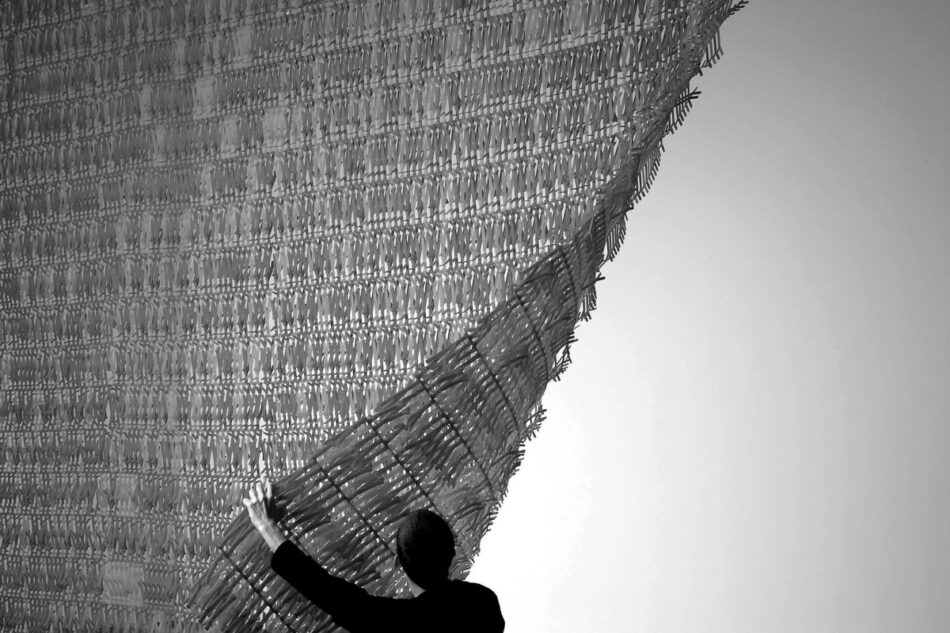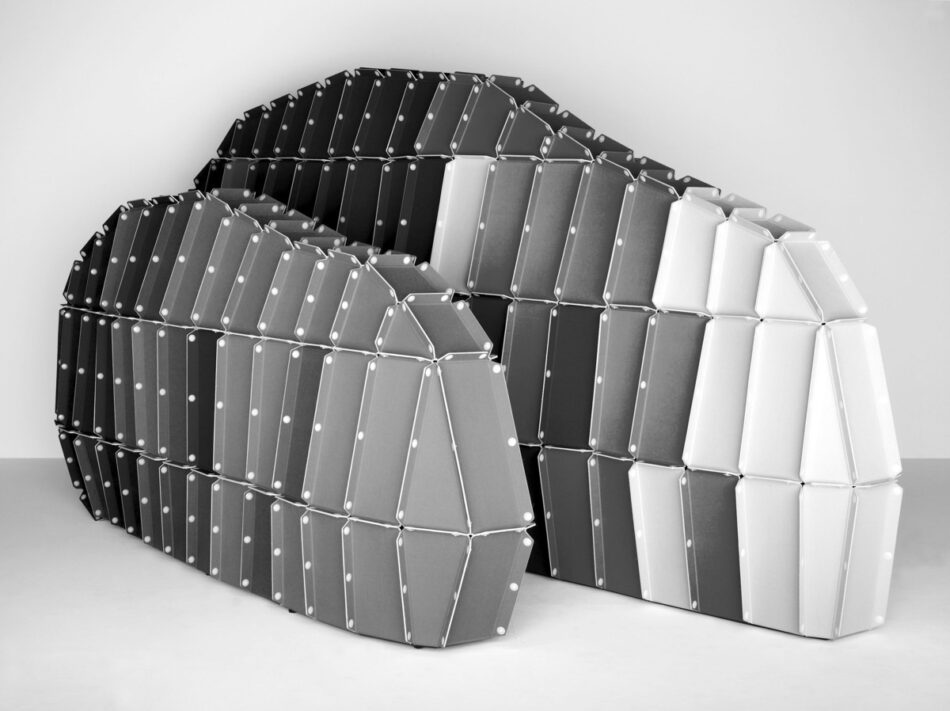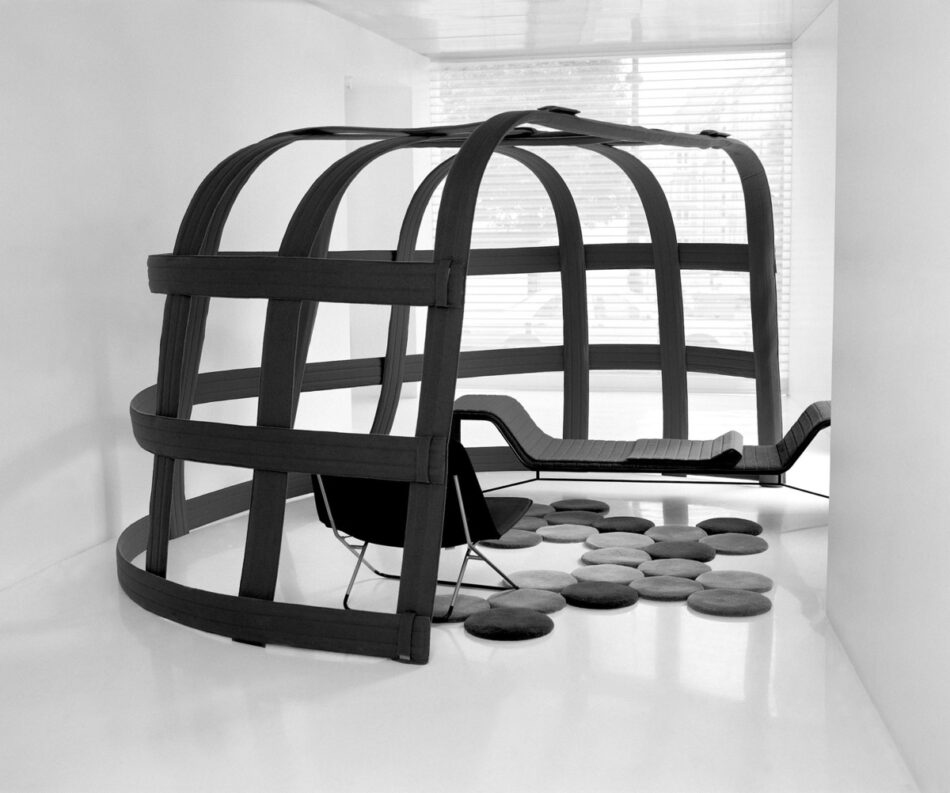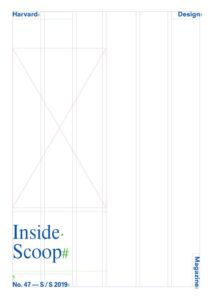Whatever Happened to “Whatever Happened to Total Design?”? The Momentary Utopian Jouissance of the Bouroullec Brothers
Despite my initial excitement, for the past few months I avoided writing anything about Ronan and Erwan Bouroullec’s work. I wasn’t sure what to do other than describe their projects, mapping them in relation to the work of other artists and designers. This would surely include references to the work of Donald Judd, Jean Prouvé, Ray and Charles Eames, Joe Colombo, and Arne Jacobsen, among others. It is easy to make comparisons: Colombo’s wicker furniture (1964) with the Bouroullecs’ Pebbles (2008); the trestle columnar structure of Prouvé’s Tropical House (1949) with the Bs’ Joyn office system (2002) and Textile Pavilion (2006); Jacobsen’s Egg chair (1958) with the Bs’ Slow chair (2007); the Eameses’ Fiberglass chair (1950) with the Bs’ Papyrus chair (2008); or Judd’s Daybed (1978) with the Bs’ Alcove seating (2006—2007); and so on. Even more than pointing out these similarities or influences, it would be easy to say that the Bouroullecs are thinking about early modernism and Minimalist art (with strategies of non-composition). When they literally collaged some of their early projects (such as Audiolab [2002] or Lit Clos [2000]) into Judd’s Marfa studio, they grafted themselves to a particular aesthetic. Instead of situating their work in this way (which is probably the more appropriate academic task), what really interests me is why we should talk about them in the first place.
Although this is the Harvard Design Magazine at the Harvard University Graduate School of Design, design itself (especially product, industrial, graphic, interior, et al.) is rarely discussed in the school. These modes of design have never been fully incorporated or even accounted for in either contemporary architectural theory or the architectural discipline. This is despite the fact that fill-in-the-blank (_____) design is often a significant part of architectural practice. In architecture we’ve been more interested in suppressing the individual desires that _____ design directly engages. Architectural methodologies and systems of logic, control, and organization continue to dominate the discourse, while _____ design is typically marginalized as a waste by-product or mere paraphernalia in the service of ambiance, decor, or good taste. While some may continue to think of _____ design as a minor, commercial, or even whimsical endeavor, expunging design from architecture only limits the scope of architectural purview and confines our influence and cultural expression. While _____ design is not necessarily architectural, it certainly influences the architectural terrain.
When I was a student 10 years ago, another issue of Harvard Design Magazine, called “Design Arts and Architecture,” sparked the conversations du jour. One article in particular, “Whatever Happened to Total Design?” by Mark Wigley, was required reading. In it, Wigley illustrated the manic bipolarity of architecture’s embrace of “total design,” the implosive and the explosive: on one hand, the “hyper-interiors” in which every little thing is designed to produce a “total work of art” in resistance to the standardization of the industrialized world; on the other, the wholehearted embrace of industrialization as a means of allowing the architect to produce every kind of object (big and small) in every context. Wigley argued that these positions, more often than not, were blurred or simply reversed, but they had always shared the same fantasy of architecture as a means of total control. Even as postmodern architects subsequently developed rhetorical strategies that purported to dismantle the grand narrative inherent in the totalizing impulse, Wigley argued that the impulse remained—the desire to totalize only grew stronger and more effective in the seamlessness through which pluralism and difference could be accommodated in the new regime. For Wigley, all design is inherently totalizing inasmuch as it is an inescapably individual-directed theoretical activity.
Although Wigley’s article seemed accurate and influential 10 years ago, I believe that design has since changed fundamentally. For the time being, architecture, design, art, and even theory have all given up on the search for a grand unifying theory or language or single equation or individual narrative that could describe the universe. The contemporary mind-set seems to have finally and sincerely let go of the impulse for totalizing theory, architecture, art, and design. While we can argue about whether this is good, the fact remains that design today operates in an environment of parallel processing within the archipelagos of culture.

Design now seeks ever more specific and situated niches. It is inclusive, but not universalizing. Internal autonomous demands and the absolute measurements of geometric systems are being replaced with relative systems of measure, mood, and atmosphere. Why something is organized one way or another has become conflated with how, a how motivated with the why of revitalized pragmatics, economy, and social instrumentality—these are now more important than the discursive, disciplinary, or compositional games with plans or facades. Utopia has been replaced with micro-utopias. (The art critic Nicolas Bourriaud illustrates micro-utopias as a “without teleology, without grand speeches, [referring] to everyday life.”1) These micro-utopias—micro-environments of newfound specificity or archipelagos of
the cultural field—overwhelm and frustrate total design.
The newfound finiteness of design is okay. Pluralism exists, like the Market, but doesn’t need to be theorized. Utopia isn’t nowhere, where it used to be. In its micro form, it is temporary and localized. Younger artists, architects, and designers aren’t rewiring all of society through design. They’re rewiring only bits. Everyone is fine with operating in smaller niches, networked enclaves, and ever more remote campsites. The specific is the new generic.
In this new condition, art and design are more similar than ever, as so-called master narratives have become diluted and dissolved, and as artists produce functional design objects. Even the distinctions in the cultural mechanics of distribution have collapsed, since a lot of design work has been sold and distributed through galleries—not as prototypes seeking to replicate themselves everywhere for a new society, but as objects that aspire only to their own micro-environment or micro-utopia (most of the Bs’ work comes in gallery-released limited editions).
More than just a mode of operation in the cultural field, the nomadic campsite and the temporary structure have become prevalent artistic tropes in the past decade. Some examples from art and design are Liam Gillick’s Discussion Island (1997); Simon Starling’s Tabernas Desert Run (2004), Island for Weeds (2003), and Autoxylopyrocycloboros (2006); Pierre Huyghe and François Roche’s Terra Incognita/Isla Ociosidad (2006); Tracey Emin’s Everyone I Have Ever Slept With 1963–1995 (1995); Andrea Zittel’s Homesteads and A-Z projects (2001–ongoing); Joep van Lieshout’s Bonnefantopia (2003) and The Technocrat (2003–2004); Rirkrit Tiravanija and Kamin Lertchaiprasert’s the land project (1998–ongoing); Lucy Orta’s Refuge Wear (1992–2007), and the Bs’ the Stitch Room (2007), Cabane (2001), and Textile Pavilion, among many others.

That said, Ronan and Erwan Bouroullec’s designs are perhaps the best of these temporary totalities, nomadic encampments, or natural environments composed of aggregated assemblies. Their worlds are discrete although made of parts and more parts, like a Michel Gondry film (Eternal Sunshine of the Spotless Mind [2004], etc.) in which the familiar is transformed into a series of oddball playful props. The Bs’ work is never solely about individual elements or fragments. Each part works in a loose, small, internal design ecosystem where it could move or grow a little more this way or that way, but still maintain its character or atmosphere. Look at their woven tapestry walls of plastic Twigs or Algues, made of thousands of soft little plastic curves that snap together, or North Tiles, in which these multicolored wool tiles tab into each other. Within all these assemblies, the joints or hinges—as simple notches, embedded tabs and pegs, or folding flaps—aren’t foci in themselves; they are parts of the piece’s loose organizational structure. The work is systemic without being tectonic.
In this way, their work always seems to place itself at an intersection between an almost natural aggregation and the man-made. Brick (2000), Cloud Modules (2002), Grape Carpet (2001), and Audiolab—actually all of their assemblies—produce a sort of micro-environment, with a modulated filigree from an immense number of parts, fabricated with a Prouvé-like do-it-yourself sensibility. (Given the large quantities of pieces, it seems as though extensive labor is never an issue in their world.) Ultimately, they produce a soft architectural system, a sort of unfinished woven fabric of flexible form—endless, scaleless, but intimate and tactile.
The Bs call their installations “micro-architecture,” but they’re more like tree houses, nomadic campsites, or picnics (similar to those of the Eameses, whose entire lives and body of work seem like one never-ending picnic). The Bs sometimes produce interventions that are minimal enclosures, places of refuge within a larger environment. The early work Audiolab, collaged into Judd’s studio, illustrates this idea. It doesn’t try to look like Judd’s work; it just camps out in it for a while.
The Bs’ work doesn’t deal with problems of enclosure or building infrastructure, and this allows it a migratory freedom. (Their camps, such as the Stitch Room, are at times like colorful quilted Bedouin tents.) But when they do come closest to dealing with enclosure, they make their nomadism all the more apparent by proposing a relationship to architecture and the ground that is all the more tenuous, as with the enlarged folding legs of Lit Clos or Floating House (2006).
The Bouroullecs have managed to produce a body of work that is provocative because it is at once specific, localized, and micro, while also coherent and lightly suggestive of the totalizing impulses of early modernism. Their soft systems often refer to the aspirations of total design to coordinate all of the activities of a life in a single design system, but do so with complete informality and an emphasis, both visual and practical, upon eclecticism and the incompleteness of these systems (in contrast to the total precision of someone like Colombo). Modules and repetition of elements appear playful, not maniacal.

The provisional quality of their soft tectonic systems suggests the possibility of endless evolution and inclusion, instead of infinite growth and domination. Their work is simply okay with the facts that design
is an orphaned object in the world and that they can’t control everything. Their campsites can be both specific and singular, but at the same time suggestive of a transitory micro-totality. They neither explode nor implode, as Wigley suggests, but rather just momentarily exist with jouissance. (The Bs’ jouissance is a sensual design equivalent to Roland Barthes’s jouissance in The Pleasure of the Text [1973].) You won’t find the sinister cold logic of total design, but a microenvironment with an incompleteness at home with itself.
The Bouroullecs’ designs exist in the world with a light touch, with a utopian impulse that is discrete, playful, and ephemeral. Their work promises only what it can provide—visceral engagement, momentary refuge in a world of beautiful visual abstractions, playful utility, comforting tactility, and temporary specificity.
Michael Meredith is associate professor at the Princeton University School of Architecture and principal at MOS, an internationally recognized architectural practice based in New York. His writing has appeared in Artforum, Log, Perspecta, Harvard Design Magazine, and other publications.
